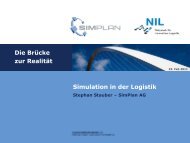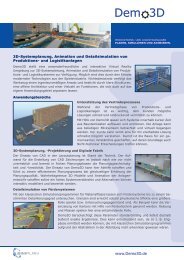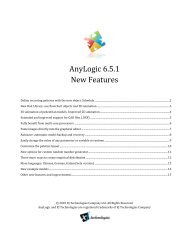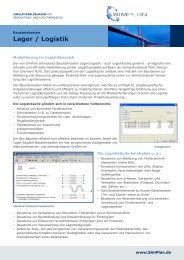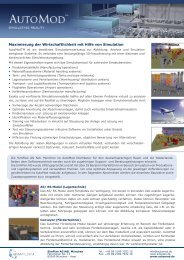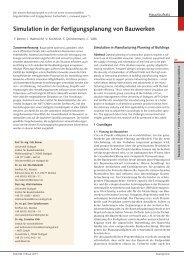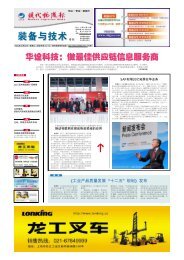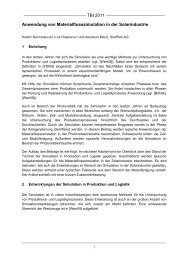Emulate3D Controls Testing
Emulate3D Controls Testing
Emulate3D Controls Testing
Create successful ePaper yourself
Turn your PDF publications into a flip-book with our unique Google optimized e-Paper software.
<strong>Emulate3D</strong> <strong>Controls</strong> <strong>Testing</strong><br />
Reduce Commissioning Time and Costs, Minimise AMHS Power Consumption<br />
<strong>Emulate3D</strong> <strong>Controls</strong> <strong>Testing</strong> is uniquely designed for cost-effective offline controls testing in the pre-commissioning phase of<br />
your AMHS project - build layouts fast from standard equipment catalogs, connect to your control system I/O, and run.<br />
Take <strong>Controls</strong> <strong>Testing</strong> Off The Critical Path<br />
The First Step to Parallel <strong>Testing</strong> - Automation projects of all types share<br />
the common problem of balancing the need for extensive logical controls<br />
testing before handover with the end user’s need to start production and<br />
generate a return on investment. In most cases the controls testing phase<br />
cannot begin until the system is physically complete and installed. The result<br />
is that testing is set back by every preceding delay on the critical path, which<br />
places it just before the handover deadline. When testing can begin, it is<br />
often under the difficult conditions created by those delays, with<br />
considerable pressure to complete the work and hand the system to the end<br />
user. Hardly textbook conditions for the production of fully tested, robust<br />
controls systems, and yet until now there was no real alternative.<br />
<strong>Emulate3D</strong> Reduces Investment Risk<br />
More <strong>Testing</strong>, Better <strong>Testing</strong> -<br />
Taking logical controls testing off<br />
the project’s critical path reduces<br />
the number of unknowns that<br />
Production lines or individual machines can be tested before construction with <strong>Emulate3D</strong><br />
contribute to the risk of the AMHS<br />
investment - risks for the integrator, and risks for the user. The project may not be ready on time, the<br />
ramp to full production may not be as smooth as required, and the user might not consider the project a<br />
success. Future investments in automation may be compromised, and the user might look to other<br />
companies to provide automation solutions.<br />
AMHS controls testing is essentially an office job requiring concentration and problem-solving skills,<br />
and yet is invariably carried out under pressure in a warehouse or a factory environment.<br />
<strong>Emulate3D</strong> <strong>Controls</strong> <strong>Testing</strong> is the means by which these risks can be reduced or eliminated.<br />
Validate The System Before it Exists<br />
Physics-Based <strong>Emulate3D</strong> Models React Just Like The Real Thing - From an I/O standpoint,<br />
<strong>Emulate3D</strong> equipment models are identical to the real systems they represent, so they provide a valid<br />
test bed for the control system. <strong>Emulate3D</strong> equipment is built to be easily connected to I/O and<br />
controlled in exactly the same way as the real thing – which means that controls engineers find the<br />
system intuitive, and can create and connect layouts rapidly. Once built, system elements can be<br />
easily modified, sensors moved, and speeds and cycle times changed. Products moving through the<br />
system may be interactively pulled from a line, moved<br />
elsewhere, or manually put through the same photo eye<br />
repeatedly. The control system response can be observed<br />
and validated, operators can be trained on the HMI, and all<br />
team members can become familiar with the system and its<br />
operation before it exists.<br />
<strong>Emulate3D</strong> <strong>Controls</strong> <strong>Testing</strong> Key Points:<br />
• The <strong>Emulate3D</strong> build environment allows models to be built fast and<br />
efficiently using reusable elements from user-defined catalogs<br />
• <strong>Emulate3D</strong> models are dimensionally and operationally accurate, and all<br />
movement can be physics-based for absolute realism<br />
• <strong>Emulate3D</strong> models allow real-time user interaction for a completely<br />
immersive test environment<br />
Test Real-Time Systems Faster Than Real Time<br />
Complex or larger systems can be validated on several computers in parallel,<br />
therefore reducing the time necessary for the task in a way that is impossible on the<br />
real system. Replacing real hardware with <strong>Emulate3D</strong> equipment helps users to<br />
identify and focus on issues with the control system. In this way, real hardware<br />
problems cannot be confused with control system operation. As offline controls<br />
testing can be carried out early in the project cycle, <strong>Emulate3D</strong> even provides the<br />
possibility of making layout or operational changes to improve the system.<br />
And all in your office environment, off the project’s critical path.<br />
<strong>Emulate3D</strong> Ltd, Reading Enterprise Hub, Earley Gate, Reading RG6 6AU, United Kingdom Telephone: +44 118 935 7388 Fax: +44 118 935 7330 www.demo3d.com<br />
<strong>Emulate3D</strong> Americas, 615 Arapeen Drive, Suite 102, Salt Lake City, UT 84108 USA Telephone: +1 801 831 5105 - Contact Matt Hobson-Rohrer
<strong>Emulate3D</strong> <strong>Controls</strong> <strong>Testing</strong><br />
<strong>Emulate3D</strong> Makes Commissioning Part of Your Competitive Advantage<br />
Prove It Works With <strong>Emulate3D</strong><br />
Validate Logic, Train Users Safely - <strong>Emulate3D</strong> provides<br />
you with a flexible means of reliably testing and validating<br />
control systems, as well as being highly effective as a<br />
credible and safe operator training platform. End users<br />
appreciate the ability to see their system being run by the<br />
actual control system before the handover deadline, and<br />
can be reassured that the throughputs they specified are<br />
being generated. By using the power consumption meters,<br />
you can even minimise your system’s carbon footprint.<br />
Reduce the On-site <strong>Testing</strong> Load - Once the hardware<br />
system is installed on site, the controls testing phase is<br />
reduced to a minimum checklist to ensure the correct<br />
connection of all sensors and outputs, as the logical<br />
verification of the system will have been completed off-site.<br />
Connecting I/O to model elements is straightforward.<br />
To connect I/O, select the <strong>Emulate3D</strong> object, click the corresponding browser cell, and hit Return. Job done.<br />
Automated Model Generation<br />
<strong>Emulate3D</strong> As Your 3D Front End - <strong>Emulate3D</strong> is<br />
designed to be used either as a stand-alone<br />
product, or as embedded technology. <strong>Emulate3D</strong><br />
models can be generated from data in flat files or<br />
databases, automating the creation process and<br />
eliminating build errors at a stroke.<br />
Leverage Your Existing CAD Libraries - Many<br />
companies have CAD or other software set up to<br />
create proposals automatically, and this data can<br />
often be used by <strong>Emulate3D</strong>, efficiently creating<br />
models in the time it takes to press a key.<br />
The <strong>Emulate3D</strong> Process<br />
<strong>Emulate3D</strong> <strong>Controls</strong> <strong>Testing</strong> models are simple to<br />
construct, connect, and run. For a manually<br />
constructed model the steps are as follows:<br />
• Create the layout from catalog elements<br />
• Add control elements<br />
• Add product arrivals<br />
• Connect control tags and equipment via<br />
the OPC browser<br />
• Run, validate, modify, improve<br />
Simply Access a Wide Variety of Data<br />
<strong>Emulate3D</strong> is constructed on the Microsoft .NET<br />
Framework, and as such can be integrated with a<br />
wide variety of data. <strong>Emulate3D</strong> models have been<br />
connected via OPC, TCP/IP, UDP, a SOAP server,<br />
and the list just keeps on growing.<br />
<strong>Emulate3D</strong> and Ongoing Improvements<br />
Following Handover, Continue <strong>Testing</strong> - The controls testing<br />
model remains of considerable value to the end user – few systems<br />
remain unchanged during their lifecycle, so any proposed<br />
modifications to the hardware or the control software should again<br />
be evaluated offline first, prior<br />
to implementation. Proposed<br />
control system changes to<br />
existing systems can be<br />
reliably tested while the<br />
system continues to produce<br />
in its current configuration.<br />
Prototyping ladder logic can be<br />
conveniently carried out by using<br />
the <strong>Emulate3D</strong> SoftPLC.<br />
<strong>Emulate3D</strong> <strong>Controls</strong> <strong>Testing</strong> Reduces Commissioning Time and Costs Because:<br />
• Control systems can be exhaustively tested, off-site<br />
• System verification can be carried out prior to the hardware build<br />
• Significant reductions in the amount of logic testing required on site are possible<br />
• Operators can be trained off-line in a realistic environment<br />
• Faster ramp can be achieved due to reduced ramp issues<br />
To know more about <strong>Emulate3D</strong> technology and how it can improve your business, please contact your local<br />
distributor or contact us directly at www.demo3d.com.<br />
<strong>Emulate3D</strong> Ltd, Reading Enterprise Hub, Earley Gate, Reading RG6 6AU, United Kingdom Telephone: +44 118 935 7388 Fax: +44 118 935 7330 www.demo3d.com<br />
<strong>Emulate3D</strong> Americas, 615 Arapeen Drive, Suite 102, Salt Lake City, UT 84108 USA Telephone: +1 801 831 5105 - Contact Matt Hobson-Rohrer



